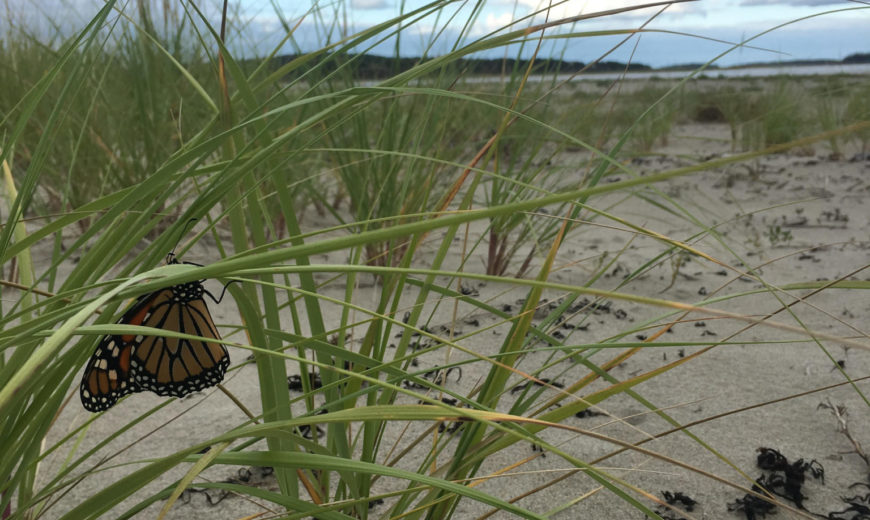Salt, Sand, and a Living Fossil: Legacies of the Champlain Sea

In 1849, a railroad worker in the inland town of Charlotte dusted off the bones of a beluga whale. After some initial confusion about whether the bones belonged to a horse, the whale would become Vermont’s state fossil. But on the shores of present-day Lake Champlain, there’s a forgotten plant that bore witness to the fossilization of the famed beluga. If Vermont’s legislature were to designate a state living fossil, beachgrass would surely claim the title.
Ten thousand years ago, the beluga whale was still swimming. Below him, the future city of Burlington was a sloping mudbank sitting at the bottom of a salty sea. Schools of fish darted into crevices in the underwater cliffs at Rock Point, and harbor seals surfaced to scan the waters between chunks of floating ice. Newly exposed by the melting glacier, the Champlain Sea would have looked much like the Arctic Ocean, where pods of beluga whales swim today.
The tail end of the Ice Age was a mud season that lasted for decades: the perfect recipe for fossilization. Having been steamrolled by ice and scraped clean of vegetation, the land was raw and roiling with dirty meltwater. Sediment rushed into the briny Champlain Sea and piled up in its mucky shallows. The beluga whale, mired on a shoal near present day Charlotte, would have shone like buffed white marble against the mud before the swirling currents buried him.
Meanwhile, beachgrass was gaining a toehold on the shoreline. If you’ve spent time on an East Coast beach, you might recognize this plant of wind-swept sand dunes and beaches.
Beachgrass is known by botanists as a sand-binder or dune-builder for its tendency to accumulate sand beneath itself. The beavers of the plant world, these ecosystem engineers build ridges of sand that rear up from the beach and run parallel to crashing waves. In the mud season of shifting sediment after the last Ice Age, there would have been ample sand blowing around the shores of the Champlain Sea with which to build dunes, and spiky clumps of coastal beachgrass would have ruled the shoreline.
But the Champlain Sea wasn’t salty for long. Paleontologists believe that the marine invasion ended about 9,000 years ago as the land rebounded from the weight of the glacier, rising above sea level. The saltwater slowly trickled north back into the sea, and streams from the mountains freshened the lake. The beluga whales moved north with the shifting arctic waters, and the wooly mammoth moved toward extinction. Slowly, the salty Champlain waters were diluted.
Beachgrass still grows along the lakeshore, a reminder that the sea once reached into the Champlain Valley. But this relic plant has become increasingly rare as development along the lake has stabilized shores and reduced the amount of sand available for dune building.
In fact, ecologists have realized that not only does beachgrass bind sand, it needs sand deposition to grow. Studies have shown that the deeper the grass is buried, the higher it grows. It’s unclear exactly why the grass relies on sand burial, but it likely suppresses the growth of other competitive species. Ironically, the populations of beachgrass that are fenced off from beach-goers often die from lack of sand deposition.
Since our prevailing summer winds come from the south, the grass grows mostly on south-facing beaches where sand comes in on the wind and waves. Botanists have shown that our beachgrass has become a genetically distinct subspecies since being isolated from the coastal grass. They called our subspecies Lake Champlain beachgrass. It even looks a bit different than its coastal cousin— our subspecies has smaller flowers with a slightly different shape.
Each year in the city of Burlington, hundreds of school children are bussed to the University of Vermont geology museum to see the Charlotte whale fossil. Some of its bones were attached backward in 1849, but the anatomical inaccuracies don’t detract from the whale’s story of deep history. The students stare through the glass case at the long snout wired shut, the rounded yellow teeth that once snatched fish from the frigid depths of an extinct finger of the Atlantic.
Forty miles north, on an island in the freshened Lake Champlain, tufts of beachgrass catch sand grains on their stiff leaf blades, collecting them one by one to build a dune.Sentinels since the last beluga whale swam through the valley, beachgrass stands as a living relic of the Champlain Sea. What’s more, these dune-builders fossilize shapes from the Ice Age landscape. Their shifting dunes are artifacts from a time when sand and salt moved freely through the valley on wind and waves, burying and building all at once.
Written by Grace Glynn
Feature photo by Grace Glynn
